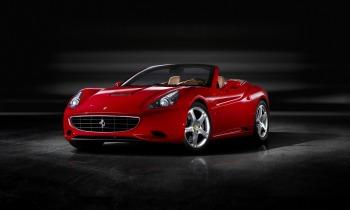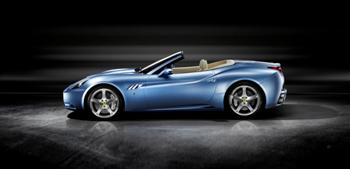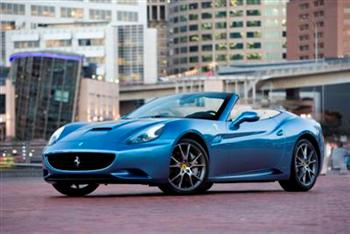|
| ||||
|
Additional Details: Ferrari California
12th October, 2008 | |||
|
The Ferrari California is the first ever front mounted V8 Ferrari, though, to be strictly accurate as the engine and drivetrain sit entirely between the axle lines, it is as much a mid-engined car as the F430. The mid-front mounted V8 engine, although built to the classic 90 degree V8, is all new and features direct fuel injection. Also new for Ferrari is the dual clutch gearbox that effectively reduces gear change times to zero, the folding metal roof and the multilink suspension that blends traditional Ferrari handling and adhesion to the road with a new level of ride quality and comfort. But, regardless of the comfort and luxury, the California is still a Ferrari and a 0-100 km/h time of less than four seconds and a top speed in excess of 310 km/h (where the law permits), means that the California remains a true super car. Local deliveries of the Ferrari California will start in mid-2009, when local specifications and prices will be announced. Styling The California's sleek aerodynamic styling is, like the rest of the current Ferrari models, the result of their long standing collaboration with Pininfarina and offers a host of signature Ferrari styling cues. Viewed from the side, the aerodynamic sweep of the bonnet contrasts with the compact tail volume and the pulled-back cabin. The front continues some of the themes hinted at on the flanks, harmoniously alternating concave and convex volumes. Seen head-on, the car clearly takes it much of its inspiration from the prestigious Prancing Horse car from which it takes its name: the grille and slender air intake at the centre of the bonnet most notably harking back to the 250 GT California. At the rear, the sides and the 'muscular' tail section are both familiar too. As at the front, the single round LED taillights are inset directly along the edge of the boot. The California's vertically stacked twin tailpipes are an original flourish as is the boot which sweeps right down to the bumpers to improve functionality. Of course, the interior also reflects the same level of design sophistication, exuding a sense of refined luxury, comfort and bespoke quality. Situated between the front seats, the new aluminium-trimmed centre console is another touch that goes beyond the merely aesthetic, beautifully combining functionality and design. 
Aerodynamics The Ferrari California's aerodynamics were, of course, developed in tandem with its styling. This allowed Ferrari to keep the Cx (drag coefficient) right down with respect to the downforce required for optimal vehicle dynamics. In the coupé configuration, the California has a Cx value of 0.32. A desire to achieve perfect balance between vertical load and drag influenced the shape of the rear diffuser and the spoiler incorporated into the front bumper. Drag has been cut to 10% lower than on the other Ferrari models which not only makes the California a more aerodynamically efficient car but also reduces fuel consumption. Last but not least, the air intake on the bonnet ensures highly efficient cooling of the engine compartment. The new 8-cylinder engine This is the first V8 in the history of Ferrari road cars to be mid-front mounted. Built entirely from aluminium, it retains the typical Ferrari architecture with a 90° angle between the two cylinder banks and a 180° angle between the cranks. The engine has a total displacement of 4,300 cc and a maximum power output of 338 kW (460 hp) at 7,750 rpm. With a specific power of 107 hp/litre, its maximum torque is 485 Nm (49 kgm) at 5,000 rpm, 75% of which is available at just 2,250 rpm. The new V8 features direct fuel injection and variable timing (on both intake and exhaust) to guarantee superb performance, exceptional handling and fuel consumption and emissions that easily comply with the Euro 5 and Lev2 standards. Thanks in part to these solutions, the Ferrari California consumes 13.1 litres/100 km (ECE combined) and has carbon emissions of a massive 305.6 grammes per kilometre (ECE combined). The California's engine sound was also carefully developed as this is one of the Ferrari signatures and really does contribute to enhancing driving pleasure. Particular attention was lavished on sound perception in the cabin both with the top up and down to ensure that trademark thrill without compromising on occupant acoustic comfort. Gearbox and transmission The Ferrari California sports a new dual clutch gearbox (7-speed + reverse) with the now traditional steering wheel-mounted F1-style paddles. This is an innovative system that guarantees a combination of performance and ride comfort. With the dual clutch, one clutch is used for even-numbered gears and the other for odd-numbered ones (just like the highly respected and award winning Volkswagen DSG), and allows the pre-selection of the next gear required. The gears are changed by overlapping the opening and closing stage of both clutches, resulting in gear shifting times that are close to zero and with no "torque interrupt". The result is not only enhanced performance but truly thrilling driving pleasure. The traditional transaxle layout (engine to the front and gearbox to the rear) also contributes to the California's perfect weight distribution (47% front - 53% rear) and to reducing vibration to the body shell. In manual mode, the new gearbox guarantees great sporty driving pleasure while extra comfort is assured in automatic. Chassis and suspension The Ferrari California's chassis and body shell are both made entirely from aluminium. Thanks to the use of different aluminium technologies (extrusions and shell casts), the car's exceptional versatility, onboard comfort and driveability has not added to chassis weight or to the dimensions of the structural sections - something that simply would not be the case had traditional steel architecture and technologies been used. Furthermore, static rigidity (torsional and flexional) has been improved with respect to average figures for a Spider to ensure exceptional handling in any kind of road conditions and to guarantee GT-standard comfort both with the top up and down. The Ferrari California retains the traditional double wishbone suspension to the front while a new multilink system has been especially developed for the rear. The multilink system improves longitudinal flexibility of the suspension, keeping transverse rigidity values high. What this means in practice is that the car beautifully absorbs any unevenness, and noise and vibration are efficiently damped for exceptional ride comfort well on a par with the car's nimble handling. The SCM Magnetorheological Suspension Control System, debuted on the Ferrari 599 GTB Fiorano, is also available on request. Retractable Hard Top The Ferrari California's signature feature has to be its retractable hard top (RHT). It is made from aluminium panels and has a cast aluminium weight-bearing structure which has reduced its overall weight and the moving masses involved. The entire opening/closing cycle is completed in 14 seconds and thanks to the original stowage system, the California's boot space remains generous regardless of whether it is up or down. The F1-Trac The Ferrari California also features the F1-Trac traction control system which can very accurately read grip, assuring the very best can be made of the car's potential at any time. The F1-Trac system guarantees:
In fact, the F1-Trac offers a 20% improvement in acceleration coming out of corners with respect to a traditional traction and control systems. Safety equipment The Ferrari California boasts an automatic roll-bar to ensure that its occupants are protected should the car overturn. The system is installed behind the backrests of the rear seats. Ejection time is under 190 ms. The onboard safety equipment is completed by front retractable airbags (driver and passenger sides), side retractable air bags in door panels, bi-xenon headlights and LED rear lights. New generation adaptive headlights, known as AFS (Advanced Front lighting System), are also available on request, and offer improved visibility on the road. The headlamp beam angles are automatically adjusted in line with steering, angle, speed and lateral acceleration, offering a wider area of illumination when cornering. 
Interior and standard equipment Particular attention has been lavished on the design and in-car comfort standard of the California's cabin. The new Ferrari is available in a choice of two configurations:
In both version, the rear backrest folds down to allow the stowage of longer items such as golf bags or skis. The boot capacity is also generous: 340 litres with the top up and 240 with the top down. A new electrically adjustable, magnesium-framed seat was also designed for the California. Another new feature is the instrument panel with analogue instruments (tachometer and rev counter) and four-screen TFT Multidisplay. The Ferrari California also boasts a new 'infotainment' system with 6.5" touch screen, Sat Nav, USB connection, Bluetooth, hard disc, voice commands and IPOD connector. Carrozzeria Scaglietti Personalisation Programme The Carrozzeria Scaglietti Programme allows all Ferrari clients to personalise their car to suit their own tastes and requirements. There are four main areas covered by the Programme: Racing and Track, Exteriors and Colours, Interior and Materials, Equipment and Travel. The Ferrari California comes with diamond-finish 19" 5-spoke aluminium alloy wheels as standard. However, a further set of diamond-finish 20" forged 5-spoke alloy wheel that are 11 kg lighter than those offered as standard can also be ordered. The aforementioned diamond-finish gives the wheels an extra-high polish look. The California is available in a choice of 16 different pastel and metallic colours. However clients also have the option of ordering the new Azzurro California shade provided especially for the car's launch. In addition to the usual range of 12 leather colours available to choose from for the interior trim too, Ferrari has added two new colours: Cioccolato and Iroko. A new racing seat with all-carbon-fibre frame and electrically adjustable backrest is also available. In addition to the already impressive list of features offered as standard with the new California, owners can also choose to have a rear parking camera fitted or order the luggage set designed specifically to make the very most of the rear bench space, an option available in addition to the traditional three-piece leather set coloured to match the interior trim, of course. Samples of the various materials and virtual configuration tools will also be available to clients at every Ferrari showroom to help them make their choices too. They may also request out of- range colours and content to really ensure their Ferrari California is absolutely unique. Pricing and specifications for the Australian and New Zealand market Ferrari California will be announced when deliveries start in mid-2009. FERRARI CALIFORNIA TECHNICAL SPECIFICATIONS Dimensions and Weights Length 4,563 mm Width 1,902 mm Height 1,308 mm Wheelbase 2,670 mm Front track 1,630 mm Rear track 1,605 mm Dry weight 1,630 kg Kerb weight 1,735 kg Weight distribution 47% Front - 53% Rear Fuel tank capacity 78 litres Boot capacity 340 litres (with roof up) 240 (with roof down) Tyres
CARBON-CERAMIC BRAKES
ELECTRONIC CONTROL SYSTEMS
ENGINE
PERFORMANCE
GEARBOX
SUSPENSION
FUEL CONSUMPTION
Note: The definition of the engine position in the Ferrari California is mid-front because while the engine is ahead of passenger compartment, the engine sits behind the front axle line and the entire drivetrain is between the axle lines, making it as much mid-engined as the F430, which is defined as a rear-mid engined car. | ||||
ABN 47106248033 |
 |
All rights reserved. |


 Following various showings of the new Ferrari California in Italy, USA and France, Kevin Wall, Ferrari
General Manager at EAI, the Australian and New Zealand Ferrari importer indicated (for reasons unknown), just a few days ago, that
“It is a unique honour for Australia to be chosen as only the second place in the world where the new California is on display,”
although he continued to say “The California name is clear indication of the importance of this new model to Ferrari, as it is one
of the marque’s most famous model names of all time and remains, as recent auction of the original cars have shown, the most sought
after classic Ferrari of all time. The new model takes Ferrari into a new area of the super car market provides a superlative gran
turismo to compliment the full-blooded super car that is the Ferrari F430.”
Following various showings of the new Ferrari California in Italy, USA and France, Kevin Wall, Ferrari
General Manager at EAI, the Australian and New Zealand Ferrari importer indicated (for reasons unknown), just a few days ago, that
“It is a unique honour for Australia to be chosen as only the second place in the world where the new California is on display,”
although he continued to say “The California name is clear indication of the importance of this new model to Ferrari, as it is one
of the marque’s most famous model names of all time and remains, as recent auction of the original cars have shown, the most sought
after classic Ferrari of all time. The new model takes Ferrari into a new area of the super car market provides a superlative gran
turismo to compliment the full-blooded super car that is the Ferrari F430.”